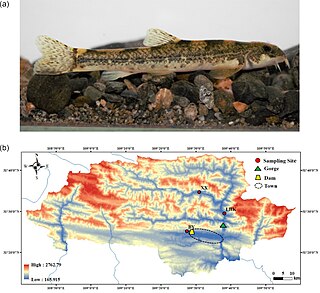Oxynoemacheilus bureschi, the Struma stone loach, is a species of ray-finned fish in the stone loach family (Nemacheilidae). It is found in the Struma, Vardar and Nestos river basins Bulgaria, Greece, North Macedonia, and Serbia Its natural habitat is rivers, preferring larger streams with fast currents, especially in the middle. It cannot survive where the rivers have been canalised and it is threatened by habitat loss. The specific name honours the Bulgarian ichthyologist Ivan Buresh, who was able to influence the Bulgarian monarch Boris III to allow Drensky to collect specimens in Bulgaria.

Triplophysa is a genus of fish in the family Nemacheilidae found mainly in and around the Qinghai-Tibet Plateau in China, as well as inland waters of the larger part of central Asia. They can be distinguished from other genera of Nemacheilidae by marked sexual dimorphism, including the development of nuptial tubercles on breeding males. Currently, the genus is a mixed assemblage of species. Some lineages have been identified and treated as subgenera, but as Wikipedia follows Fishbase for fish species all but Hedinichthys have been treated as subgenera in Wikipedia, although Kottelat in his revision of the loaches did recognise them as valid. FishBase, however, includes these in Triplophysa without specifying subgenera and treats the names given by Kottelat as synonyms.
Schistura melarancia is a species of ray-finned fish, a stone loach, in the genus Schistura. It is found in the Mekong drainage in Laos and Vietnam. The specific name melarancia is derived from an old Italian word for an orange and refers to the orange-brown colour of the fins and body of this species.
Schistura nandingensis is a species of ray-finned fish, a stone loach in the genus Schistura from the Nanding River drainage in Yunxian County, Yunnan.
Yunnanilus beipanjiangensis is a species of ray-finned fish, a stone loach, in the genus Yunnanilus. Its type locality is the Beipanjiang River system, Yunnan Province, China.
The arrow loach is a species of ray-finned fish in the genus Nemacheilus.
Triplophysa alexandrae is a species of stone loach in the genus Triplophysa endemic to Sichuan, China.
Triplophysa angeli is a species of stone loach in the genus Triplophysa. It is endemic to the Yalong River in Sichuan, China. It grows to 12.9 cm (5.1 in) SL.
Triplophysa arnoldii is a species of stone loach in the genus Triplophysa. It is endemic to Mongolia. It grows to 7 cm (2.8 in) SL.

Triplophysa bleekeri is a species of stone loach in the genus Triplophysa. It is endemic to China. It grows to 8.2 cm (3.2 in) TL. Having a wide distribution across the Qinghai-Tibet Plateau, it lives in fast-flowing rivers from 200 to 3,000m in altitude. Being an unusual species inhabiting high-altitude regions, it is an excellent model to investigate the genetic mechanisms of adaptation to the local environment. With this in mind a chromosomal-scale genome assembly was sequenced and assembled with a genome size of ~628 Mb. This data finding that the Triplophysa genus likely diverged when the Qinghai-Tibet Plateau elevated by >4,000 m roughly 40 million years ago.
Triplophysa choprai, the snow loach, is a species of ray-finned fish in the subgenus Indotriplophysa of genus Triplophysa.
Triplophysa farwelli is a species of stone loach in the genus Triplophysa. It is found in Iran and the Helmand River drainage in Afghanistan.

The Tibetan stone loach is a species of ray-finned fish in the family Nemacheilidae. The specific name is sometimes spelled stoliczkae but the original spelling used by Steindachner is stoličkai. It is found in southern and central Asia.
Claea dabryi is a species of stone loach endemic to the Jinshajiang river basin in China. Commonly known as 戴氏南鰍, which translates as Dai's southern loach.
Yunnanilus qujinensis is a species of freshwater ray-finned fish, a stone loach which is endemic to China. The species was described from specimens collected at a spring into the Hujiafen Reservoir in the Nanpanjiang River drainage near Qujing in Yunnan, its Specific name (zoology) refers to the city of Qujin. It has not yet been included in FishBase.
Triplophysa anshuiensis is a species of stone loach in the family Nemacheilidae. It is endemic to Lingyun County in Guangxi, China, where it lives in a karst cave.

Triplophysa ferganaensis, known as the Fergana stone loach, is a species of ray-finned fish in the family Nemacheilidae. It is endemic to the Shohimardonsoy stream in Fergana Valley, Uzbekistan. It lives in fast-flowing rivers over 1500m in altitude.
Triplophysa bellibarus is a species of stone loach in the genus Triplophysa.
Triplophysa wulongensis is a species of ray-finned fish in the genus Triplophysa endemic to a single subterranean pool in Furong Cave, Wulong County, Chongqing, China.
Dzihunia pseudoamudarjensis, the Uzbekistan stone loach, is a species of ray-finned fish in the family Nemacheilidae. It is endemic to the Fergana Valley, Uzbekistan. It lives in slowly flowing, turbid water of the Great Fergana Canal.



